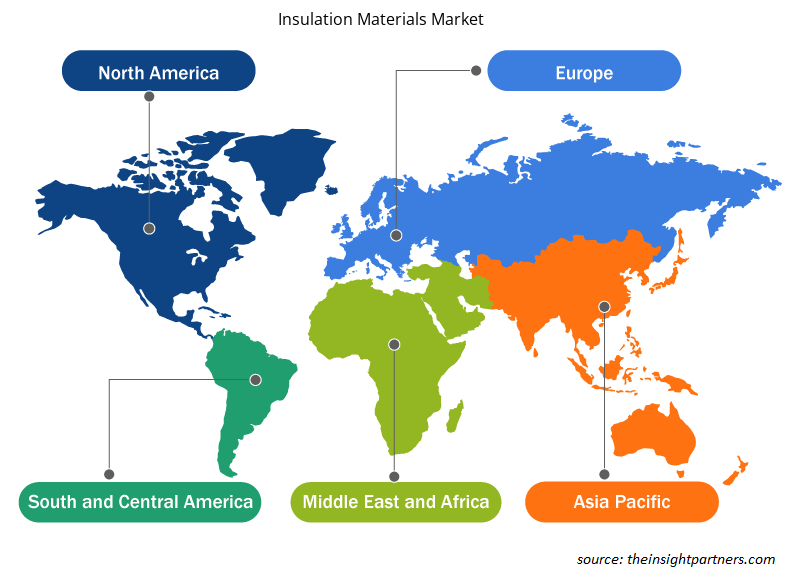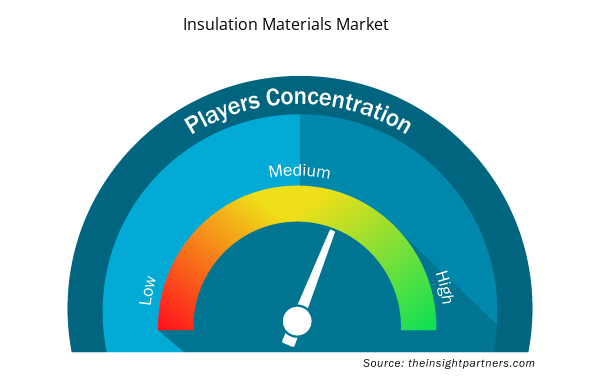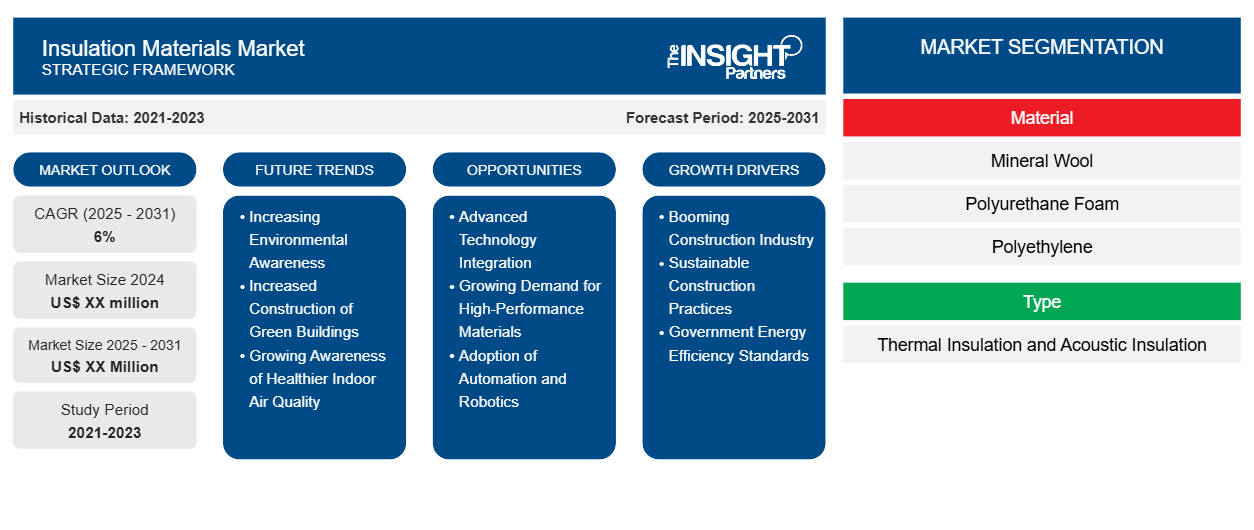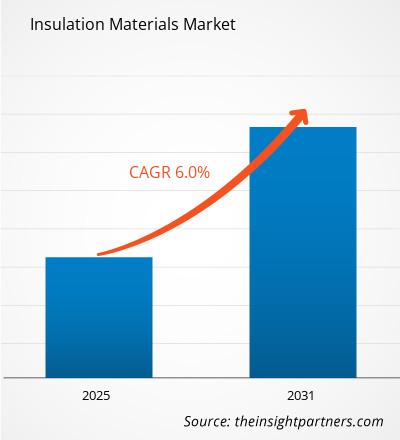Si prevede che il mercato dei materiali isolanti registrerà un CAGR del 6% dal 2023 al 2031, con una dimensione di mercato in espansione da XX milioni di dollari nel 2023 a XX milioni di dollari entro il 2031.
Il rapporto presenta analisi basate sul materiale (lana minerale, schiuma di poliuretano, polietilene, fibra di vetro, polistirene e altri). Il rapporto è segmentato per tipo (isolamento termico e isolamento acustico). Il rapporto è segmentato per applicazione (automotive, aerospaziale, navale, elettrico ed elettronico, edilizia e costruzioni, petrolio e gas e altri). L'analisi globale è ulteriormente suddivisa a livello regionale e nei principali paesi. Le dimensioni del mercato e le previsioni a livello globale, regionale e nazionale per tutti i principali segmenti di mercato sono coperte nell'ambito. Il rapporto offre il valore in USD per l'analisi e i segmenti di cui sopra. Il rapporto fornisce statistiche chiave sullo stato di mercato dei principali attori del mercato e offre tendenze e opportunità di mercato.
Scopo del rapporto
Il report Insulation Materials Market di The Insight Partners mira a descrivere il panorama attuale e la crescita futura, i principali fattori trainanti, le sfide e le opportunità. Ciò fornirà spunti a vari stakeholder aziendali, come:
- Fornitori/produttori di tecnologia: per comprendere le dinamiche di mercato in evoluzione e conoscere le potenziali opportunità di crescita, consentendo loro di prendere decisioni strategiche informate.
- Investitori: condurre un'analisi completa delle tendenze relative al tasso di crescita del mercato, alle proiezioni finanziarie del mercato e alle opportunità esistenti lungo la catena del valore.
- Enti di regolamentazione: regolamentano le politiche e le attività di controllo sul mercato allo scopo di ridurre al minimo gli abusi, preservare la fiducia degli investitori e sostenere l'integrità e la stabilità del mercato.
Segmentazione del mercato dei materiali isolanti
Materiale
- Lana minerale
- Schiuma di poliuretano
- Polietilene
- Fibra di vetro
- Polistirolo
Tipo
- Isolamento termico e isolamento acustico
Applicazione
- Automobilistico
- Aerospaziale
- Marino
- Elettrico ed elettronico
- Edilizia e costruzione
- Petrolio e gas
Geografia
- America del Nord
- Europa
- Asia-Pacifico
- America del Sud e Centro
- Medio Oriente e Africa
Geografia
- America del Nord
- Europa
- Asia-Pacifico
- America del Sud e Centro
- Medio Oriente e Africa
Personalizza questo report in base alle tue esigenze
Riceverai la personalizzazione gratuita di qualsiasi report, comprese parti di questo report, o analisi a livello nazionale, pacchetto dati Excel, oltre a usufruire di grandi offerte e sconti per start-up e università
- Scopri le principali tendenze di mercato in questo rapporto.Questo campione GRATUITO includerà analisi di dati che spaziano dalle tendenze di mercato alle stime e alle previsioni.
Fattori trainanti della crescita del mercato dei materiali isolanti
- Industria edile in forte espansione: il mercato dei materiali isolanti è guidato dall'industria edile in forte espansione. L'urbanizzazione e la popolazione sempre più numerosa creano un aumento della domanda di nuovi edifici residenziali e commerciali. Le maggiori attività di costruzione richiedono soluzioni di isolamento di migliore qualità per garantire una maggiore efficienza energetica e soddisfare gli standard edilizi odierni.
- Pratiche di costruzione sostenibili: c'è anche la consapevolezza della costruzione sostenibile, che aumenta la domanda di isolamento. L'efficienza energetica nelle strutture è la preoccupazione principale per qualsiasi costruttore al mondo in questi giorni, con un minor consumo di energia e minori emissioni di gas serra. L'isolamento rientra in questi obiettivi e l'investimento è in materiali isolanti di qualità superiore che affrontano la sostenibilità e migliorano le prestazioni dell'edificio nel suo complesso.
- Standard governativi di efficienza energetica: oltre a questo, i governi che hanno imposto standard di efficienza energetica negli edifici stanno inducendo la crescita. La maggior parte dei paesi in tutto il mondo ha imposto rigidi codici edilizi e aumentato gli standard di isolamento degli edifici. Standard di isolamento più elevati richiedono che le aziende di costruzione utilizzino materiali isolanti migliori; pertanto, la domanda di isolamento nel mercato aumenta.
Tendenze future del mercato dei materiali isolanti
- Maggiore consapevolezza ambientale: la crescente consapevolezza dell'ambiente sta plasmando i materiali isolanti di origine biologica come pionieri nella preoccupazione del focus del mercato dell'isolamento. Consumatori e costruttori si stanno concentrando sulla sostenibilità poiché i consumatori optano per opzioni di origine biologica, che includono cellulosa, canapa e lana, per ottenere prestazioni termiche efficaci con un apporto relativamente basso di combustibile fossile, rendendo questa opzione attraente per la preoccupazione ambientale delle parti interessate.
- Aumento della costruzione di edifici verdi: inoltre, le politiche governative che rendono gli edifici verdi stanno aumentando la domanda di isolamento a base biologica. Diversi paesi hanno messo in atto alcuni incentivi e regolamenti per incoraggiare l'uso di materiali "verdi" nell'edilizia. Tale supporto politico alimenta la crescita del mercato e spinge i produttori verso l'innovazione nello sviluppo di tecnologie per l'isolamento a base biologica. Pertanto, espandono le loro applicazioni in vari progetti.
- Crescente consapevolezza di una migliore qualità dell'aria interna: oltre ai vantaggi ambientali, molti materiali isolanti di origine biologica offrono anche una migliore qualità dell'aria interna. Molti dei prodotti non contengono sostanze chimiche nocive, quindi gli ambienti di vita e di lavoro diventano molto più sani. Man mano che le preoccupazioni sulla qualità dell'aria interna aumentano, costruttori e proprietari di case sono più propensi a rivolgersi a opzioni di origine biologica, il che a sua volta stimolerà la domanda.
Opportunità di mercato dei materiali isolanti
- Integrazione tecnologica avanzata: si prevede che l'integrazione tecnologica avanzata sbloccherà significative opportunità di crescita nel mercato dei materiali isolanti. I sistemi di isolamento intelligenti che impiegano sensori e la tecnologia Internet of Things consentono il monitoraggio e l'ottimizzazione dell'efficienza energetica in tempo reale. I dati così forniti tramite tali sistemi di isolamento intelligenti possono avvantaggiare gli utenti in quanto possono prendere decisioni consapevoli in merito all'energia utilizzata e all'efficacia del loro isolamento.
- Domanda crescente di materiali ad alte prestazioni: oltre a questo, materiali ad alte prestazioni come pannelli isolanti sottovuoto e aerogel vengono sviluppati e stanno rapidamente spingendo le capacità di isolamento. Questi materiali avanzati offrono una resistenza termica superiore in profili più sottili, attraenti per architetti e costruttori che cercano di massimizzare lo spazio con bassi costi energetici. Questa attenzione alle prestazioni alimenta la domanda di soluzioni di isolamento all'avanguardia.
- Adozione di automazione e robotica: inoltre, l'efficienza produttiva e i costi vengono conservati tramite automazione e robotica nei processi di produzione. Di conseguenza, le aziende saranno in grado di garantire prezzi competitivi con materiali isolanti di qualità. Questo aumento della produttività porterà a un ulteriore accesso ai mercati di nuove regioni.
Approfondimenti regionali sul mercato dei materiali isolanti
Le tendenze regionali e i fattori che influenzano il mercato dei materiali isolanti durante il periodo di previsione sono stati ampiamente spiegati dagli analisti di Insight Partners. Questa sezione discute anche i segmenti e la geografia del mercato dei materiali isolanti in Nord America, Europa, Asia Pacifico, Medio Oriente e Africa e America centrale e meridionale.

- Ottieni i dati specifici regionali per il mercato dei materiali isolanti
Ambito del rapporto di mercato sui materiali isolanti
| Attributo del report | Dettagli |
|---|---|
| Dimensioni del mercato nel 2023 | XX milioni di dollari USA |
| Dimensioni del mercato entro il 2031 | XX milioni di dollari USA |
| CAGR globale (2023-2031) | 6% |
| Dati storici | 2021-2022 |
| Periodo di previsione | 2024-2031 |
| Segmenti coperti | Per materiale
|
| Regioni e Paesi coperti | America del Nord
|
| Leader di mercato e profili aziendali chiave |
|
Densità dei giocatori del mercato dei materiali isolanti: comprendere il suo impatto sulle dinamiche aziendali
Il mercato dei materiali isolanti sta crescendo rapidamente, spinto dalla crescente domanda degli utenti finali dovuta a fattori quali l'evoluzione delle preferenze dei consumatori, i progressi tecnologici e una maggiore consapevolezza dei vantaggi del prodotto. Con l'aumento della domanda, le aziende stanno ampliando le loro offerte, innovando per soddisfare le esigenze dei consumatori e capitalizzando sulle tendenze emergenti, il che alimenta ulteriormente la crescita del mercato.
La densità degli operatori di mercato si riferisce alla distribuzione di aziende o società che operano in un particolare mercato o settore. Indica quanti concorrenti (operatori di mercato) sono presenti in un dato spazio di mercato in relazione alle sue dimensioni o al valore di mercato totale.
Le principali aziende che operano nel mercato dei materiali isolanti sono:
- Società di coperture Atlas
- BASF SE
- Bayer AG
- Società Bridgestone
- Evonik Industries AG
Disclaimer : le aziende elencate sopra non sono classificate secondo un ordine particolare.

- Ottieni una panoramica dei principali attori del mercato dei materiali isolanti
Punti chiave di vendita
- Copertura completa: il rapporto copre in modo completo l'analisi di prodotti, servizi, tipologie e utenti finali del mercato dei materiali isolanti, fornendo una panoramica olistica.
- Analisi degli esperti: il rapporto è compilato sulla base della conoscenza approfondita di esperti e analisti del settore.
- Informazioni aggiornate: il rapporto garantisce la pertinenza aziendale grazie alla copertura di informazioni recenti e tendenze nei dati.
- Opzioni di personalizzazione: questo report può essere personalizzato per soddisfare le esigenze specifiche del cliente e adattarsi in modo appropriato alle strategie aziendali.
Il rapporto di ricerca sul mercato dei materiali isolanti può quindi aiutare a guidare il percorso di decodifica e comprensione dello scenario del settore e delle prospettive di crescita. Sebbene possano esserci alcune preoccupazioni valide, i vantaggi complessivi di questo rapporto tendono a superare gli svantaggi.
- Analisi storica (2 anni), anno base, previsione (7 anni) con CAGR
- Analisi PEST e SWOT
- Valore/volume delle dimensioni del mercato - Globale, regionale, nazionale
- Industria e panorama competitivo
- Set di dati Excel



Report Coverage
Revenue forecast, Company Analysis, Industry landscape, Growth factors, and Trends

Segment Covered
This text is related
to segments covered.

Regional Scope
North America, Europe, Asia Pacific, Middle East & Africa, South & Central America

Country Scope
This text is related
to country scope.
Domande frequenti
The growing demand for bio-based insulation materials is expected to be the key market trends.
Based on geography, Asia Pacific held the largest share of the insulation materials market due to rapid urbanization and industrialization in countries such as China and India have significantly increased construction activities. This surge in new residential and commercial buildings drives demand for insulation materials to improve energy efficiency and meet building codes.
Based on material, the polyurethane foam segment is expected to witness the fastest growth during the forecast period
The growing construction industry is driving the market growth.
Atlas Roofing Corporation; BASF SE; Covestro AG; Bridgestone Corporation; Evonik Industries; GAF; Huntsman International LLC.; Kingspan Group; ROCKWOOL International A/S; and Dow are some of the key players operating in the insulation materials market
The Insulation Materials Market is estimated to witness a CAGR of 6% from 2023 to 2031
Trends and growth analysis reports related to Chemicals and Materials : READ MORE..
The List of Companies
- Atlas Roofing Corporation
- BASF SE
- Bayer AG
- Bridgestone Corporation
- Evonik Industries AG
- GAF
- Huntsman International LLC
- Kingspan Group
- ROCKWOOL International A/S
- The Dow Chemical Company
The Insight Partners performs research in 4 major stages: Data Collection & Secondary Research, Primary Research, Data Analysis and Data Triangulation & Final Review.
- Data Collection and Secondary Research:
As a market research and consulting firm operating from a decade, we have published and advised several client across the globe. First step for any study will start with an assessment of currently available data and insights from existing reports. Further, historical and current market information is collected from Investor Presentations, Annual Reports, SEC Filings, etc., and other information related to company’s performance and market positioning are gathered from Paid Databases (Factiva, Hoovers, and Reuters) and various other publications available in public domain.
Several associations trade associates, technical forums, institutes, societies and organization are accessed to gain technical as well as market related insights through their publications such as research papers, blogs and press releases related to the studies are referred to get cues about the market. Further, white papers, journals, magazines, and other news articles published in last 3 years are scrutinized and analyzed to understand the current market trends.
- Primary Research:
The primarily interview analysis comprise of data obtained from industry participants interview and answers to survey questions gathered by in-house primary team.
For primary research, interviews are conducted with industry experts/CEOs/Marketing Managers/VPs/Subject Matter Experts from both demand and supply side to get a 360-degree view of the market. The primary team conducts several interviews based on the complexity of the markets to understand the various market trends and dynamics which makes research more credible and precise.
A typical research interview fulfils the following functions:
- Provides first-hand information on the market size, market trends, growth trends, competitive landscape, and outlook
- Validates and strengthens in-house secondary research findings
- Develops the analysis team’s expertise and market understanding
Primary research involves email interactions and telephone interviews for each market, category, segment, and sub-segment across geographies. The participants who typically take part in such a process include, but are not limited to:
- Industry participants: VPs, business development managers, market intelligence managers and national sales managers
- Outside experts: Valuation experts, research analysts and key opinion leaders specializing in the electronics and semiconductor industry.
Below is the breakup of our primary respondents by company, designation, and region:

Once we receive the confirmation from primary research sources or primary respondents, we finalize the base year market estimation and forecast the data as per the macroeconomic and microeconomic factors assessed during data collection.
- Data Analysis:
Once data is validated through both secondary as well as primary respondents, we finalize the market estimations by hypothesis formulation and factor analysis at regional and country level.
- Macro-Economic Factor Analysis:
We analyse macroeconomic indicators such the gross domestic product (GDP), increase in the demand for goods and services across industries, technological advancement, regional economic growth, governmental policies, the influence of COVID-19, PEST analysis, and other aspects. This analysis aids in setting benchmarks for various nations/regions and approximating market splits. Additionally, the general trend of the aforementioned components aid in determining the market's development possibilities.
- Country Level Data:
Various factors that are especially aligned to the country are taken into account to determine the market size for a certain area and country, including the presence of vendors, such as headquarters and offices, the country's GDP, demand patterns, and industry growth. To comprehend the market dynamics for the nation, a number of growth variables, inhibitors, application areas, and current market trends are researched. The aforementioned elements aid in determining the country's overall market's growth potential.
- Company Profile:
The “Table of Contents” is formulated by listing and analyzing more than 25 - 30 companies operating in the market ecosystem across geographies. However, we profile only 10 companies as a standard practice in our syndicate reports. These 10 companies comprise leading, emerging, and regional players. Nonetheless, our analysis is not restricted to the 10 listed companies, we also analyze other companies present in the market to develop a holistic view and understand the prevailing trends. The “Company Profiles” section in the report covers key facts, business description, products & services, financial information, SWOT analysis, and key developments. The financial information presented is extracted from the annual reports and official documents of the publicly listed companies. Upon collecting the information for the sections of respective companies, we verify them via various primary sources and then compile the data in respective company profiles. The company level information helps us in deriving the base number as well as in forecasting the market size.
- Developing Base Number:
Aggregation of sales statistics (2020-2022) and macro-economic factor, and other secondary and primary research insights are utilized to arrive at base number and related market shares for 2022. The data gaps are identified in this step and relevant market data is analyzed, collected from paid primary interviews or databases. On finalizing the base year market size, forecasts are developed on the basis of macro-economic, industry and market growth factors and company level analysis.
- Data Triangulation and Final Review:
The market findings and base year market size calculations are validated from supply as well as demand side. Demand side validations are based on macro-economic factor analysis and benchmarks for respective regions and countries. In case of supply side validations, revenues of major companies are estimated (in case not available) based on industry benchmark, approximate number of employees, product portfolio, and primary interviews revenues are gathered. Further revenue from target product/service segment is assessed to avoid overshooting of market statistics. In case of heavy deviations between supply and demand side values, all thes steps are repeated to achieve synchronization.
We follow an iterative model, wherein we share our research findings with Subject Matter Experts (SME’s) and Key Opinion Leaders (KOLs) until consensus view of the market is not formulated – this model negates any drastic deviation in the opinions of experts. Only validated and universally acceptable research findings are quoted in our reports.
We have important check points that we use to validate our research findings – which we call – data triangulation, where we validate the information, we generate from secondary sources with primary interviews and then we re-validate with our internal data bases and Subject matter experts. This comprehensive model enables us to deliver high quality, reliable data in shortest possible time.


 Ottieni un campione gratuito per questo repot
Ottieni un campione gratuito per questo repot